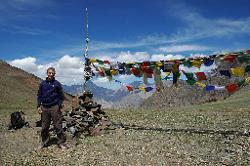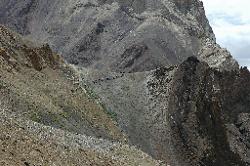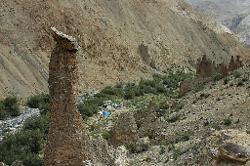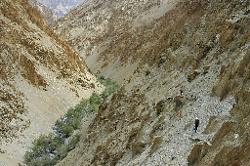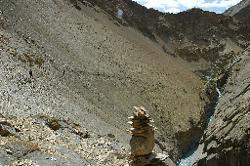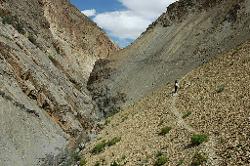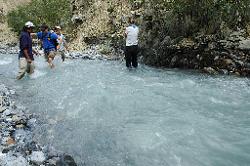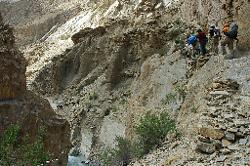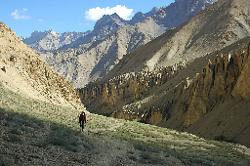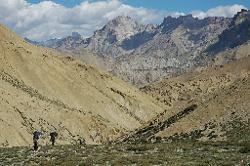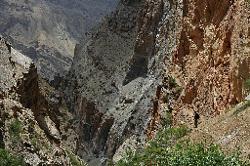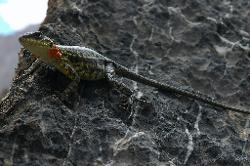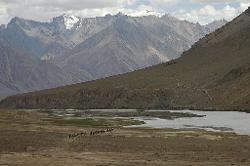MyHimalayasimpressions from |
|
|||||||

Ladakh to Zanskar: Nyerak to Zangla
Nierak - Takti La - Bear Valley Camp (Day 11)
We're ready early to leave for a tough day of hiking. The horseman who spent the night up in the pastures to guard the horses against wolves, is driving the pack animals down while we have breakfast.
It is not very hot yet, and with stomachs full pancakes, chapatis and omelettes we're quickly gaining ground and rest above the gompa and look back over the village's green plateau against the backdrop of the mountains we've crossed the last three days.
It's a constant 1'200 m climb, with some false passes thrown in between, until we reach Takti La. The pass itself sits atop of a gently sloped plateau with views toward north and south. To be quite honest, the view does not justify the effort it took us to get there. The panorama is limited, and does not reveal anything new. All of us are all rather tired after the long walk of the last hours, but Andrea and Ger find energy to walk up another slope to reach 5'000 meters. After lunch we drop most of the altitude very quickly in a steep descent, but have to gain some of it to climb a mini-pass. Martin and Andrea arrive while I'm resting. We don't want to wait for Lobsang, therefore descend into the second narrow gorge and are happy to see horse shit as re-assurance we're on the right "track". There's no trail down the wild creek, we stumble across rocks and boulders that lie scattered along its bank. Washed out rocks stands like organ pipes in the valley. Rock cairns appear and we follow them down, crossing the creek a few times until the valley becomes more level and lush scenery greets us. Willows, rose hip, flowers and tall grass are a wonderful change, especially after the slog in the morning up the barren slope.
We meet no bears (though it's not hard to imagine them living here), and sadly no other animals either. I'm wondering how far the campsite is, or if we managed to pass it without noticing it. I thought I saw a tent from higher up, was it just imagination? Leaving the riverbed and climbing up to a little plateau, we're relieved to see the dining tent just below us. We descend through the organ-pipes and through thorny bushes - not the wisest short-cut but I'm eager for: 1. a wash in the creek, 2. pakora and chips for snacks, and 3. a rest in my tent. Actually, the priorities are different.
Everybody is tired and enjoys the warm afternoon before lunch. A fire was lit to scar away the bears, and the dancing flames shine through the tent as I fall asleep.
Bear Valley Camp - Phargunsa (Day 12)
We walk down along the creek, following in the small and sometimes hard to detect trail that crosses the river several times. Willows grow along the water, the walls of the valleys are barren rock. The gorge narrows to a width of a few feet, the water gushes through the smooth channel and there's no choice but taking off shoes and wade through the cold water. Then the walls seem to close above us, we can't see the sky and for a few meters walk through the natural tunnel. Quite spectacular, and harmless since the water level is not high and therefore the current not strong. As long as one avoids stepping on slippery rocks and doesn't get dizzy by the water, there's no risk of stumbling.
After another half hour in the valley bottom we climb up a loose slope. A shaky trail has been built by piling slabs of rock in the most precarious places. The crew went ahead to check out the trail, so we rest at the river bend and enjoy the views. At first I think I'm crazy because the river suddenly flows in a different direction. It take some time to realize we're above the confluence of rivers from two different valleys, and the combined river flows in the direction we can't look into. The trail is safe, and we continue with another traverse of a precarious and unfixed barren scree slope with the river thundering far below. Some minutes later, we cross the fast flowing river, again without problems.
Just as we've crossed, the horses overtake us and we follow in their tracks. They scramble up the steep trail, send rocks down and create little clouds of dust. Even the precarious spot where boulders are piled on top of trunks spanning a wide gap in the track that was chiseled out of the vertical rock face does not scare the horses. Then down over a rock where it's impossible to belief that horses can take such huge step downwards. The resilience and flexibility of these animals is amazing. The drivers are very attentative and know which horse might face which problem at which spot, and are ready to help out. Another narrow gorge and tunnel, Lobsang wades upstream through waist-deep water; we take the zig zag trail steeply up the cliff and avoid the water.
A nice and wide valley with isolated willow trees awaits us on the other side. Steep cliffs and rock pillars rise above the barren flanks of yellow stone. Fresh bear drops lies in the middle of the path, but since the horses went ahead any bear would have fled already. Animal tracks crisscross the slope across the river, but sadly tracks is all we see of them into this remote valley. At lunch spot Kim beliefs to have a heard a bear splashing through the river. We look for it Joel sees some prints on the other side of the creek, but no sign of the bear. They can be quite aggressive when surprised, and avoiding them is a good idea.
Our campsite is on top of a plateau above the creek, and we face rock pillars that look like judges down on us. It's another hot afternoon, towards sunset I go down to the river, sit comfortably on a rock, legs stretched on a tree-trunk in the river. I'm completely at ease, it's one of those rare moments where everything feels right, the mind is not really thinking anything, and all you want is to be alone and prolong the moment for as a long as possible. The rushing of the river doesn't completely drown out the sound of wind in the leaves, and sometimes a gentle breeze makes me shiver in a pleasant way.
Dinner is great, for starters we enjoy wine (which I skip) and cheese, followed by the regular soup, then dal baht with spinach, plus pleasant conversation for desert with Indian sweets and Swiss cookies.
Despite the short distance it felt a more rewarding trekking day than yesterday. We walked barely three hours, but covered a variety of terrain, waded through the river, and spent a great afternoon at this isolated spot.
Phargunsa - Namtse La - Zangla (Day 13)
There's no sight of the horses before breakfast, or during breakfast, or after breakfast. We pack and walk up to little dip in the crest, and meet the horses on they way who were not successful in finding them. They must have wandered far off during the night in search for grass. We cross the little pass that is marked by three chortens made out of stacked branches and blue sheep horns on top. A strange monument, I've never seen anything similar before. The valley sees very few visitors, even herders don't seem to come here often during summer. We drop down into a similar valley where the sun hasn't risen above the steep walls yet. This gives us an hour of cool temperatures. On the way was more bear droppings, but it looked quite old.
The opening of the valley into gentle pastures is marked by two doksahs, primitive rock shelters that are occupied for some days by people from Zangla who come up here in summer. They bring their sheep and yak up to the pastures on the gentle hillsides. The steep slopes above the canyon are covered by green bushes and grass, I'm eagerly looking for bharal and ibex, but in vain. There's some tracks in the barren hillside, indicating that wildlife does come down to the river to drink, but that's all. Red-tailed birds hide in the rose hip bushes, ravens use the upwind on the slope to scan the hillside for food. As the willow trees get less and the creek becomes smaller, we leave the valley for more open space and climb up the hillside in the south. The open space with rolling hills is quite a contrast to the last few days. Dark and yellow bushes cover the ground, far at the horizon is the Zanskar range with patches of snow. We're surrounded by gentle hills. Ascending in little gullies between the hills is not a steep climb, but a long walk that offers not much variety. As we climb higher more mountains are revealed, and the black rock of Singe peak acts as a signpost. It is quite impressive to see the distance and terrain we covered in the last few days.
The pass hardly feels like one, it's just a dip between two of the many hills here. Namtse, "top of the sky", will lead to a steep drop of almost 1'000 meters. The first part offers a short-cut, then we enter an impressive gorge. Between steep cliffs that shoot high into the sky we follow the creek westwards In summer the flood has ripped parts of the valley walls down and carried huge boulders down. Therefore the trail is precarious at some spots where walking on the rubble isn't possible. So we slide down, trying to not to slip while steering the direction away from the edge and watching for falling stones from higher up.
It's an interesting hike down, not that easy but with good views. As we bend around a corner a different landscape lies at our feet: The Zanskar plain. After a week in gorges and on high passes I have almost forgotten that other, more gentle forms of scenery exist. The eyes rest on the wide piece of flat land. The wide valley of Padum, created by glaciers and the Zanskar river a long time ago is completely flat, the wide brown river runs through a large area of green grass. At the doksahs near the river some people from Zangla stay here with their goats, mules and dzos because the grazing is excellent. In winter they return to their village. The fort of Zangla looks very close, built atop a steep hill it overlooks the valley. Wind picks up as we walk upstream on a wide gravel bed, fighting against the wind.
This was a bad summer for farmers, first the torrential rain followed by a locust plague. As we walk through the grass, dozens of grasshoppers jump up with every step we take, it's quite disgusting. Finally I catch up with the horsemen who suddenly stopped, the entire caravan has come to a halt. We're in a muddy part with little rivulets, definitely not the campsite. Then I see the reason for the halt. A horse got stuck in a deep mud hole and is sinking quickly in the quicksand. The horse gets unloaded, but by now it has sunk with both hind legs, and more worrisome, has stopped fighting against its fate. To see it lying so still and not panicking is a bizarre sight. The horsemen act very cool, grab the horse by its head, but it doesn't come out and sinks even deeper. It's heart-breaking to see the horse suffering. Then they grab it by the front legs, hit it gently and the horse manages to get out. Calmly it waits to be loaded and walks the last five minutes to camp as if nothing had happened.
The scene will repeat itself half an hour later with another victim. Ger sinks into the mud, luckily Louise reacts quickly and avoids a more serious accident than just muddy shoes and pants.
The campsite is excellent. Tents are spread out on the wide grassy area, with small water channels nearby and a spring for a decent wash. The views towards Zangla where the fort towers above the village are fine, the village lies at the bottom of the fort. Wind picks up further and turns into a storm, the toilet tent is almost blown away, the dining tent fares better.
After sunset the views down the river reveal silhouettes of cragged mountains that stand out against the blue sky and the illuminated white and grey clouds.
|
Summary Part 4:
We are off the beaten track, and climb up for hours to Takti La
pass, a strenuous hike that takes us high up. After a steep
descent we enter a remote valley where the trail crosses the
creek frequently. The next day the gorge becomes so narrow that
we have to walk inside the water, traverse some steep slopes and
navigate tricky parts on the narrow trail. Animal tracks
traverse the barren slopes, but we do not make acquintance with
the bears that roam in the valley. Another day, another pass,
another steep descent, and we reach the flat valley of Zangla. |
